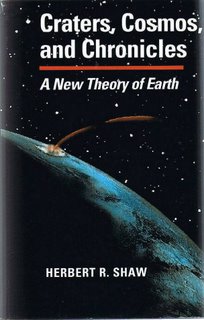Craters, Cosmos and Chronicles

Herbert Shaw, another bard in the long tradition of literature emanating from the U.S. Geological Survey (having served there as a geologist from 1959 to 1995), was born on this day in 1930 in San Mateo County, California.
In his book Craters, Cosmos and Chronicles: A New Theory of Earth
Shaw was an incorrigible scientific eclectic, known to cut a swath in such diverse specialties as magma rheology, thermal modeling, experimental geochemistry and even fractal geometry and linguistics (not to mention poetry, sculpting and painting) -- which corresponds with his desire in Craters to recast the many disciplines of earth sciences as essential parts of one whole, a truly interdisciplinary geo-cosmology.
In the world of science, it may be true that the 20th century was the century of the physicist, but at the end of the 21st century, it is quite possible that we will all be in awe at the breathtaking prescience found in the ideas of our 20th century geologists. Or, what the heck -- maybe Shaw was just crazy.
Shaw passed away on August 26, 2002 in Menlo Park, California.
Labels: Books, Geology, Physicists, USGS





0 Comments:
Post a Comment
Subscribe to Post Comments [Atom]
<< Home